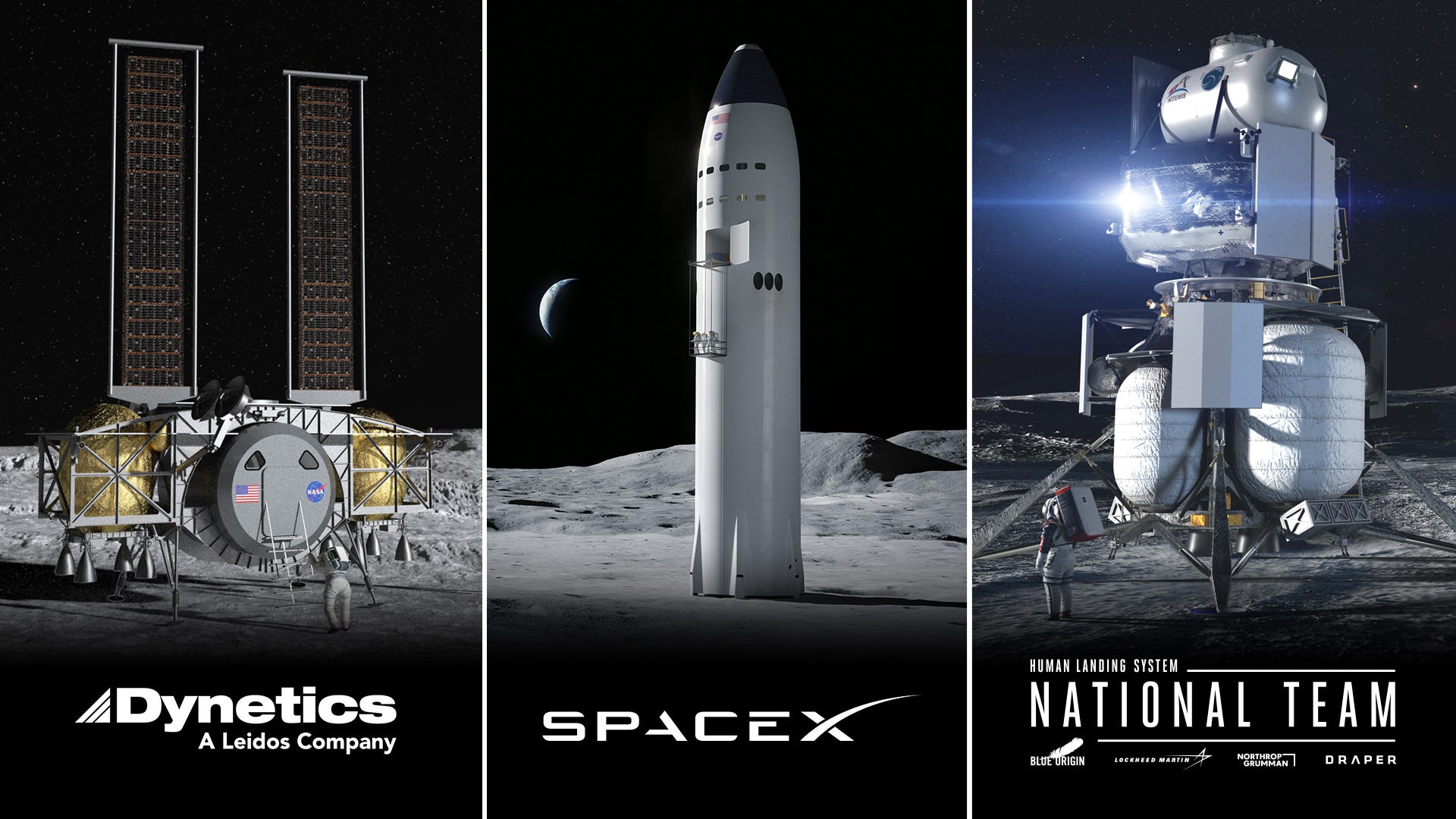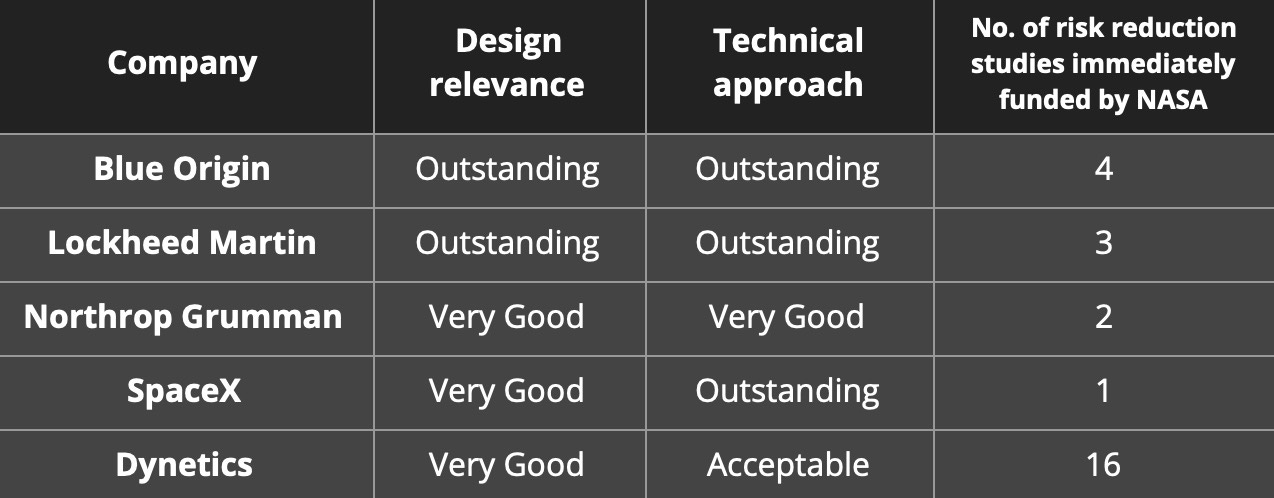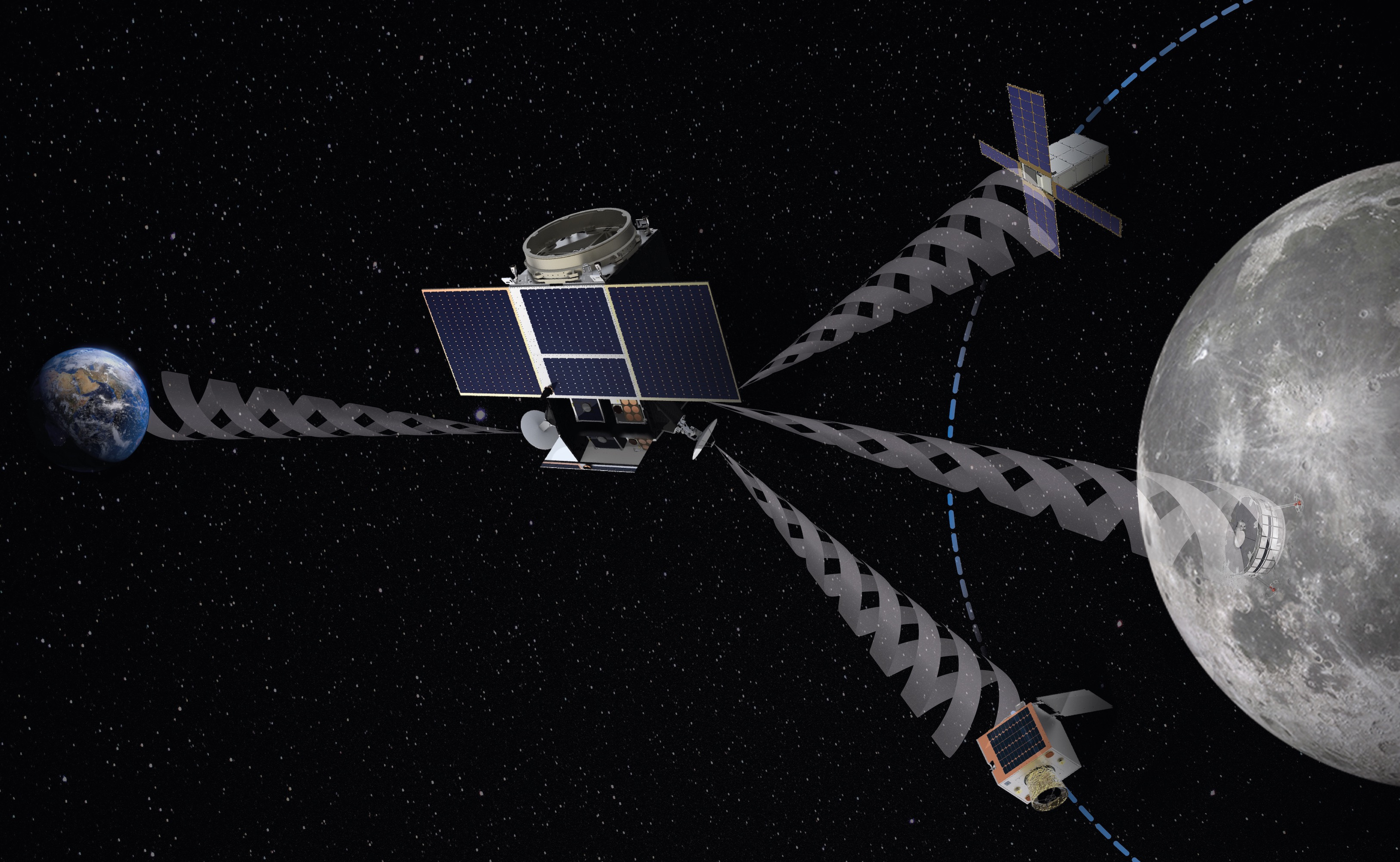Moon Monday Issue #45
NASA progresses lander developments to regularly send humans to the Moon, ESA to buy a commercial lunar communications service, scientists bounce light off of a lunar orbiter, and more lunar updates.
Highlight
NASA has officially set in motion one of the most important pieces to sustain human presence on the Moon. As part of its Lunar Exploration Transportation Services (LETS) program, NASA has awarded a total of $146 million to five U.S. companies for advancing their crewed lunar lander concepts in specific ways to make their designs reliable, cost-effective, and sustainable by the way of them being built as a commercial service to regularly ferry astronauts to and fro the Moon. NASA also wants such landing systems to separately deliver large amounts of mission-critical cargo alongside crewed missions. The selected companies and the amounts awarded to them for 15-month studies are:
- Blue Origin: $25.6 million
- Lockheed Martin: $35.2 million
- Northrop Grumman: $34.8 million
- SpaceX: $9.4 million
- Dynetics: $40.8 million

Two more companies—Blue Ridge and Cook & Chevalier—submitted timely proposals but didn’t get selected. Keen followers of the Artemis program will note that Lockheed Martin and Northrop Grumman were part of the National Team led by Blue Origin, and lost their bid to SpaceX Starship to land the first Artemis astronauts on the Moon. SpaceNews reports that both companies are continuing their involvement in the National Team but keeping their options open for future missions. To me, all signs point to these companies preparing to go their independent ways, until a future proposal bid makes it convenient to team up again.
NASA is awarding firm fixed-price and milestone-based contracts to these companies. The source selection document says the awards were chiefly determined based on proposals for two things: 1) The quality of sustainable crewed lunar lander concepts and 2) the companies proposing desired number of specific studies to reduce risks in the technologies to be used on those landers. As such, the award amounts weren’t decided on a competitive basis but rather evaluated independently for each proposal based on two enabling NASA’s needs for the program: Design relevance and Technical approach. Here are those adjectival ratings each company got, and the number of risk reduction studies NASA decided to fund right away.

While the source selection document doesn’t mention much of anything on the actual designs of the proposed landing systems, partly to preserve trade secrets, it has some comments that I found interesting enough to highlight in terms of added context or new information. Take these not as being representative of the full selection process but as small windows looking into a palace.
For Blue Origin:
Blue Origin’s proposal is thorough and compelling, of exceptional merit, and fully responds to the objectives. The relevance of their technical approach and business plan provides an outstanding list of technologies that will help facilitate future crewed lunar surface landings and provides a phased approach for extensible technology maturation to get to Mars.
[…]
Of significant note is Blue Origin’s use of a Technical Evaluation Committee that provides an independent review prior to any key milestone with the (U.S.) Government.
For SpaceX:
SpaceX’s proposal builds upon their vehicle design and extensive capability for both crew and cargo.
[…]
SpaceX’s exceptional technical approach leverages design solutions that have previously been demonstrated and certified for human space flight and state of the art infrastructure, including key facilities and equipment used for production and testing.
[…]
SpaceX’s initially funded task order work includes risk-reduction activities related to landing site analysis for its sustainable Human Landing System architecture.
[…]
The relevance and technical approach of SpaceX’s proposal provide exceptional value for NASA.
For Lockheed Martin:
Lockheed’s proposal includes an architecture and specific technologies that collectively demonstrate an attractive approach for the development of a sustainable lunar lander with features that are significantly applicable to NASA as well as the commercial space industry.
[…]
The relevance and technical approach of Lockheed Martin’s proposal provide excellent value for NASA.
These new studies will ultimately help shape NASA’s strategy and requirements for when it solicits actual lander proposals next year, whose funding will be determined by U.S. Congressional appropriations. As per a previous development in the program, the first commercial crewed lunar landing service(s) will be funded no later than 2028, and selected entities will provide regular flights soon after.
Exploration
The European Space Agency (ESA) has signed a contract with Surrey Satellite Technology Ltd (SSTL) worth $23.5 million to get lunar communications services from SSTL’s Lunar Pathfinder orbiter. Lunar Pathfinder will launch in 2024 and operate in a frozen elliptical orbit at least 8 years, from where it will relay communications between robotic mission hardware on or at the Moon and Earth at low costs. SSTL hopes for their communications service to be commercially used primarily by robotic surface missions on the Moon’s farside, where a relay is needed, and by missions on the lunar poles, where Earth visibility is limited due to our planet being low on the horizon.

For ESA, the service could be utilized by their multipurpose Large Logistics Lander whose missions include delivering cargo for astronauts on the Moon, bringing samples, and more. One proposed site for a sample return mission is the pristine Schrödinger basin on the Moon’s farside. Moreover, NASA is considering ESA’s proposal to use Lunar Pathfinder’s data-relay services for commercial Moon landing missions under NASA’s CLPS program.
Additionally, Lunar Pathfinder will host a number of experiments:
- An ESA GNSS receiver to determine its position using GPS and Galileo satellites. This will allow Pathfinder to autonomously know its position with an error margin of less than 100 meters, more accurate than traditional ground tracking. NASA also wants to extend the use of GPS to the Moon, and will be testing a similar system on its CLPS provider Firefly’s first mission in 2023.
- A NASA retro-reflector to demonstrate laser ranging capabilities.
- An ESA radiation monitor to study orbital radiation conditions.
In May 2021, ESA selected SSTL for its Moonlight initiative as one of the two companies leading a developmental study to demonstrate the feasibility of a full-scale commercial lunar communication and navigation service, with the intention to especially serve the higher data needs of crewed missions. ESA wants Moonlight to be active by 2028.
Engineers at NASA Glenn Research Center’s Ballistic Impact Lab are shooting small steel ball bearings at several kilometers per second on a variety of materials that could be used in astronaut spacesuits and future habitats on the Moon. This to study how these materials would fare on the Moon, which is constantly bombarded by speedy micrometeorites. No pictures seem to be available of the ripped off materials though, sadly.
Building and maintaining sustainable habitats on the Moon would require extracting and processing huge amounts of lunar soil, whose metals will be useful as construction and shielding material and whose oxygen as air and fuel. But as we’ve learnt from the Apollo missions, lunar dust can be a nuisance as well as a hazard to nearby people and hardware. The Colorado School of Mines are hosting a global Over the Dusty Moon challenge to seek innovative working ideas that can transport lunar soil over long distances with minimal dust kickoff.
NASA is funding two-year project proposals led by early-career employees across the agency to develop new crewed lunar exploration technologies for their Artemis program. These proposals include radiation-tolerant displays and interface systems housed inside crewed lunar spacecraft, increasing autonomy in missions operations via ground control systems, and autonomously erected communication and navigation-aiding towers for the Moon’s poles.
Masten has revealed the name of their first Moon landing mission in 2023 as part of NASA’s CLPS program to be Xelene (pronounced zuh-leen), based on the Greek Moon goddess Selene.
Science
For decades scientists have been bouncing lasers off of 5 reflectors left on the Moon by the Apollo missions. This has helped us learn the nature of the Moon’s core and, among other things, that the Moon is drifting away from Earth at about 3.8 centimeters per year. But these reflectors have become less efficient over time by being exposed to the harsh lunar environment. Scientists suspect it’s because of dust kicked up by micrometeorites but they don’t really know! In an effort to understand the degraded performance of the Apollo reflectors, NASA and French scientists have been bouncing light off of the smaller-sized retroreflector array onboard NASA’s Lunar Reconnaissance Orbiter (LRO) for the past few years.

As you can imagine, reflecting light off of a speedily moving orbiter around the Moon and detecting it is as difficult as it is cool. The idea is to compare the performance of the Apollo reflectors and the LRO one, and use the differences to identify the reasons for the degraded performance of the Apollo ones. However, more observations are needed to be able to do so, and know if lunar dust can really be blamed. Related: China’s Chang’e 4 farside lunar mission’s relay satellite Queqiao also has a small hollow corner cube reflector.
On September 3, 2021, China released the 18th batch of scientific data from the Chang’e 4 mission. The data released is from the lander and rover’s 22nd lunar day, specifically from the lander’s radio instrument, and the rover’s camera, ground-penetrating radar and infrared spectrometer. By the end of August 2021, the duo had completed their 33rd lunar day, and the rover has driven a total of 799 meters.
Here’s a nice account on the activities that NASA astronaut Kathleen Rubins performed as part of ESA’s ongoing Pangaea campaign to train astronauts in geology, a highly valuable skill in exploring the Moon’s surface and collecting samples. Kathleen is part of the astronauts group selected for NASA’s Artemis program, and could become the first woman to land on the Moon.
More Moon
South Korea is launching its first Moon mission in less than a year. With it, South Korea forays into planetary exploration, begins its ambitious lunar exploration program, and finds a collaborator in NASA. I wrote the mission’s details for The Planetary Society.
I also wrote a follow-up post on how this mission will inspire kids and students in South Korea, and how India's Chandrayaan 1 did the same for me.
I can't wait for its instruments to show us novel views of our Moon, notably from NASA's ultrasensitive camera onboard, which can see shadows as if they're sunlit!
Thank you Dr. Gordon Roesler and Dr. Tamasi Kar for supporting me and powering this edition of Moon Monday.
Everyone, I’m publishing this one-of-a-kind Moon exploration newsletter for free, with no ads. And it will stay that way. If you like my comprehensive coverage of lunar exploration and science, your support will keep it going.
